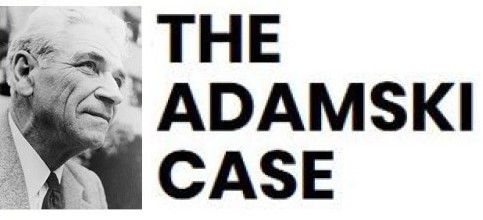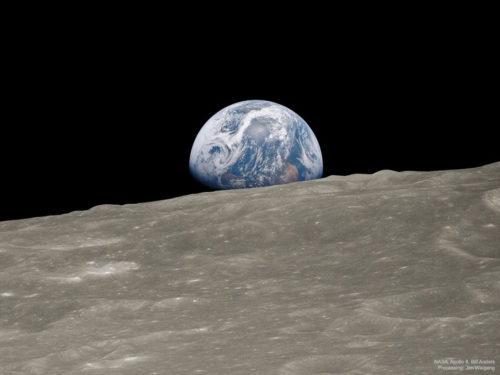Earthrise (Image: NASA, Apollo 8 🔗 Crew, Bill Anders; Processing and License: Jim Weigang)
“The main thing is NOT a question of saucers, my experiences or anybody else’s. The main thing is WHAT IS REALLY TRANSPIRING IN THIS WORLD. THAT is more important than any individual or phenomena that is taking place at this moment.” –George Adamski, at a press conference with ministers in Detroit, September 1955 (Many Mansions, p.3)
“The time has arrived that the study of what the Brothers have already given is more important than the saucers, if we are to have a better world, or prepare ourselves for the things yet to come… The individual life is more important to understand than all the spacecraft in the cosmos.” –Adamski in a letter to William T. Sherwood, April 1964 (as quoted in his article ‘UFO Understanding: An American Perspective’, 17 July 1983)
Modern transport, information and communications technology, and scientific discoveries have changed our experience of the physical world to that of an interconnected global community. Our political, economic, financial, and social structures, however, still reflect a worldview based on division and competition for territory, power and wealth. For this reason Adamski was told — as were many other contactees in similar terms: “Now that your scientific knowledge has so far outstripped your social and human progress, the gap between must be filled with urgent haste.” (Inside the Space Ships, p.137)
Against the background of this mounting crisis in consciousness, which is reflected in unprecedented levels of inequality and social injustice 🔗, it was George Adamski’s mission “to boldly show” what no 20th century man, or very few, had seen before — that Life is One, that it manifests through the evolution of consciousness, and that the human stage in that evolution is a universal occurrence.
From his long-forgotten debut The Invisible Ocean (1932) through to Cosmic Philosophy (1961) and Science of Life (1964), Adamski taught about the evolution of consciousness, in line with the teachings on the spiritual facts of life that he had studied in his early youth with the Masters of Wisdom in Tibet 🔗, whose existence was first revealed in modern times through the work of Helena P. Blavatsky 🔗, founder of the Theosophical movement. (See also: His reputation 🔗.)
Claim: Showing the connection between Adamski and the Masters of Wisdom, or the wisdom teachings, is “a convoluted circus of misinformation and misdirection”.
Source: George Adamski Foundation LLC proprietor Glenn Steckling, in his Prologue to Behind the Flying Saucer Mystery II (2016, p.54).
Facts: (1) Although he did not want anything to do with ‘Masters’ as presented by mediums and psychics, Adamski spent several years studying with the Masters in Tibet as a youth. In The Invisible Ocean (1932) he mentions “the masters of Tibet” (p.21), while he published their teachings in Wisdom of the Masters of the Far East (1936). (2) About his use of the term ‘Master’ in Inside the Space Ships, in 1958 Adamski wrote: “Because it has been so misunderstood and misinterpreted by students of certain philosophies, I have often regretted my use of the word ‘Master’ in referring to those wise ones whom I met on the space ships…” (Cosmic Science, Q#60) Yet, throughout his writings he repeatedly referred to the teachings of the ‘Men of Wisdom’. (3) If Life is universal and manifests through the evolution of consciousness, as Adamski taught 🔗, the existence of Masters of Wisdom is not an undesirable mystical notion, but merely the logical next kingdom in nature above the human, as consciousness manifests and evolves upward, through the subhuman and human kingdoms and beyond, on this and any other planet. The only thing undesirable would be a lack of discernment between this super-human kingdom in nature and the fanciful channelings of psychics. As Adamski said: “Man’s inability to recognize his potential has been the cause behind the perversion of our present teaching.”
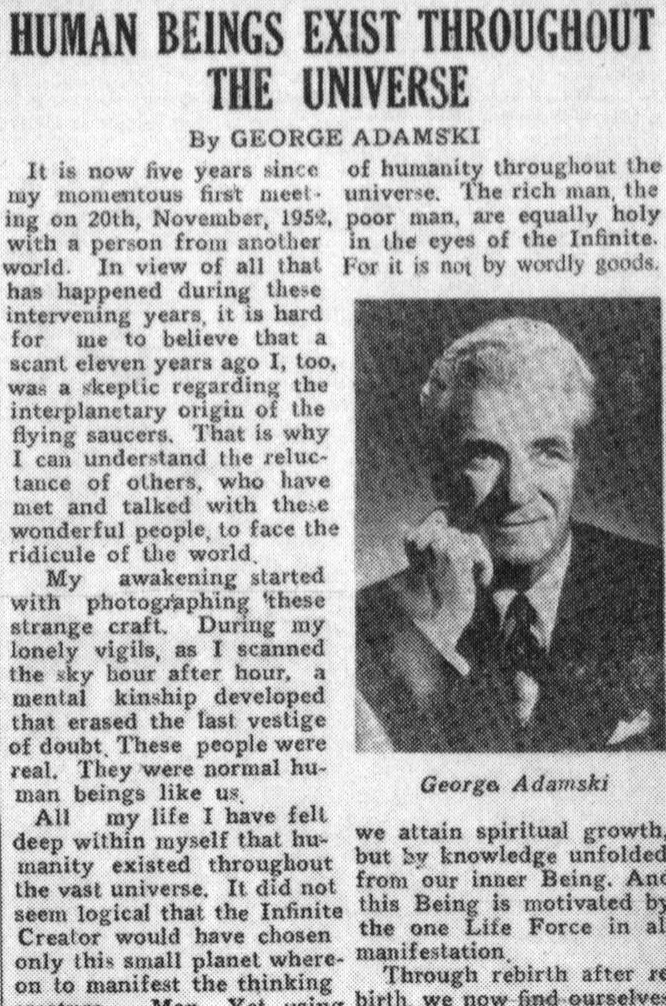
Given his training with these custodians of the wisdom teachings it is very well possible, and likely, that Adamski was aware of and in contact with visitors from other planets long before his reported first contact in the California desert on 20 November 1952.
Even before his accounts and photos put him in the limelight, the public’s fascination with the ‘flying saucers’ was growing fast, beginning with the ‘foo-fighter’ light balls 🔗 that were observed on the trail of fighter jets of both the Allied and Axis powers during WWII. With the development and deployment of the atom bomb, and the growing risk of humanity’s nuclear annihilation due to the post-war arms race between the Eastern and Western blocks, the flying saucers began to draw more attention to their presence. The fact that they were, and still are, concerned about our nuclear capability 🔗 was first reported by various of the 1950s ‘contactees’, beginning with Adamski, and is confirmed by contemporary reports from (former) US military personnel in research by Robert Hastings.
Meanwhile, Adamski had already installed a 6-inch telescope at the Temple of Scientific Philosophy in Laguna Beach in 1938, “to create an interest in the study of astronomy”. His first publication about extraterrestrial life was an essay titled The Possibility of Life on Other Planets (1946), followed three years later by Pioneers of Space, in which he gave detailed descriptions of his out-of-body experiences on the Moon, Mars and Venus. It is more than likely that these were presented in a tentative manner because he was not yet supposed to come out with his experiences.
In his foreword to Pioneers of Space Adamski writes “this is at present in the field of fiction”, leading many critics to conclude that his book Inside the Space Ships (1955) was fiction because of the close similarity of some of his descriptions in both books. Yet, in private correspondence in August 1950 Adamski explained that his experiences prior to 1952 had taken place as out-of-the-body experiences.* And in 1964 he explicitly distinguishes between his travels in consciousness and “my trips in space craft taken bodily”. (Science of Life course, Lesson Five)
Students of the wisdom teachings, and consciousness researchers, know that this does not make his experiences any less real, because we are not a physical body with self-consciousness, but rather a “cluster of vibrations” in a sea of consciousness, an individualized aspect of the Cause — the Self — that expresses and experiences life in incarnation as the person that we know as “me” — our personality. Referring to the meaning of the original Latin persona, as a mask used by actors to portray a character, in September 1950 Adamski said: “Man for ages … has been and is nothing but a shadow, a mask. And this mask takes itself for reality. Being an effect, it is guided by effects and knows not the Cause 🔗…”
Adamski’s mission to make the world aware of the reality that humanity is found throughout Cosmos, including our own solar system, can be seen as extending from his teaching on the evolution of consciousness. This, in turn, is integral to the Ageless Wisdom teaching, as presented for our times in the works of Helena P. Blavatsky (1861-1891), which gained her as much defamation as did Adamski for his mission.
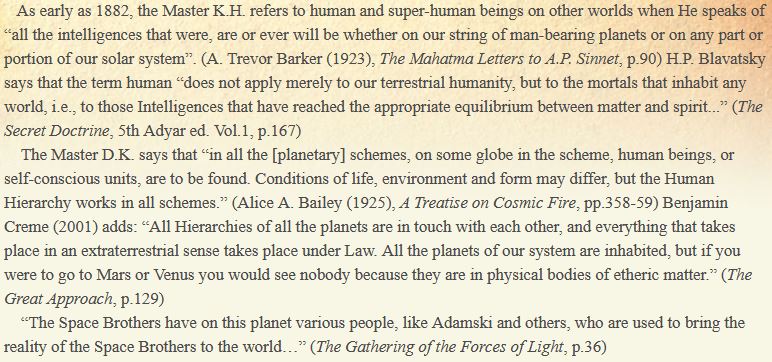
According to Alice A. Bailey, Benjamin Creme and others who followed in Blavatsky’s footsteps, these teachings are reintroduced to the modern world at this juncture in history to guide mankind through the crisis in consciousness that accompanies our transition into a new cosmic cycle🔗 now, at the end of the old age, when the old ways and structures — political, economic, financial, social, et cetera — no longer work or fit humanity’s needs.
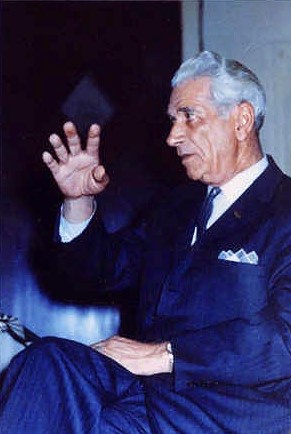
Although he didn’t say much more about it, at least not publicly or explicitly, in a lecture he gave in Detroit, MI, USA, in September 1955 George Adamski indicated that he was well aware of these circumstances 🔗, in which his mission plays a crucial part, when he said: “…it states in our own Bible that in the latter days (as we might call it at the moment) that when these things will be happening … like ‘signs in the sky and war and rumors of war’ … we will have come to an end of a cycle, or as some people call it, a ‘dispensation’.” (World of Tomorrow, p.1)
So while it is clear that Adamski’s mission was not to be the standard-bearer for the new age, neither was it a unique, stand-alone affair. Instead, it was yet another stage in the ongoing education of humanity that life is a universal occurrence that expresses itself through the evolution of consciousness.
* See Lou Zinsstag (1990), George Adamski — Their Man on Earth, p.190. Also referenced in Timothy Good (1998), Alien Base, p.150.
FAIR USE NOTICE: This page may contain (links to) copyrighted materials the use of which has not been specifically authorized by the copyright owner. The Adamski Case publishes (links to) these materials solely for educational and research purposes, constituting Fair Use in accordance with Title 17 U.S.C Section 107 of the US Copyright Law, and Article 5 of the European Directive 2001/29/EC. Please contact The Adamski Case about any copyright or attribution issues.
